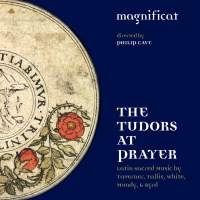Texte paru dans: / Appeared in:

Fanfare Magazine: 38:2 (11-12/2014)
Pour
s'abonner / Subscription information
Les abonnés à Fanfare Magazine ont accès aux archives du
magazine sur internet.
Subscribers to Fanfare Magazine have access to the archives of the magazine
on the net.
Linn
CKD447

Code-barres / Barcode : 0691062044721
As anyone who collects recordings of Renaissance sacred polyphony knows, the multifarious small ensembles devoted to that art—at least in England—draw upon many of the same singers in ever-changing combinations for their members. (Scheduling rehearsals, concerts, and recording sessions must be a veritable logistical nightmare for all involved.) One consequence is that some of those ensembles lead an on-again, off-again existence, coming to life when the zodiacal stars governing such matters come into favorable alignment for realization of some (usually long-planned) project. One such ensemble is Magnificat, under the direction of Philip Cave. Originally founded in 1991, it has issued recordings sporadically in the subsequent 23 years, of which this appears to be the ninth. All of its releases have deservedly met with high acclaim, with the series of three discs devoted to Philippe Rogier being of particular musicological importance.
This disc offers a brief survey of four decades of devotional music for the Tudor monarchs of England from c. 1530 to c. 1570—a tumultuous period dominated by a whiplash vacillation between pre-Tridentine Roman Catholicism and the nascent Protestant Reformation, which under Elizabeth I finally attained an uneasy equilibrium, with an ostensibly comprehensive state church delicately poised between dogged recusants and Puritan firebrands. Amidst these theological sea changes, however, the Latin motet continued to flourish as a devotional and musical art form, even with the definitive and final shift to use of an English-language liturgy for worship with Parliament’s authorization of the third edition of The Book of Common Prayer in 1559. (Remarkably, the moderately Protestant Elizabeth not only employed the recusants Tallis and Byrd as court composers, but in 1575 granted them a 21-year monopoly in the printing of music and ruled music paper in the realm. The first major fruit of that was the 1575 collection of 34 Latin motets, Cantiones que ab argumento sacrae vocantur.) The works included here range from the pre-Reformation period (Taverner), to the Marian restoration of Catholicism (Tallis, White’s Tota pulchra est, and Mundy’s Vox patris caelestis), to works adaptable either to sanctioned Anglican services or to the devotions held in private chapels of recusant nobility (Byrd and the other motets by Mundy and White).
This disc contains the only recordings listed in print by ArkivMusic of Mundy’s Adhaesit pavimento and White’s Tota pulchra est. Most of the other works have only two or three other recordings available (usually by the Tallis Scholars and/or The Sixteen), though Taverner’s Quaemamodum has five alternatives listed (one an instrumental version with the viol ensemble Fretwork). Comparing the performances on this CD against various ones in my collection, I preferred Magnificat in every instance except one, the exquisite Gallicantus recording of White’s Domine, quis habitabit (III) that I reviewed in 33:6, and even then the two were very close. The SACD recorded sound is exceptionally clear, deep, and spacious; the booklet contains informative notes, complete Latin-English texts, a list of the singers, and bios and photos for Philip Cave and Magnificat. Let’s hope that the recent uptick in frequency of recording by this splendid ensemble is a long-term trend rather than a momentary spike; enthusiastically recommended.
Cliquez l'un ou l'autre
bouton pour découvrir bien d'autres critiques de CD
Click either button for many other reviews


